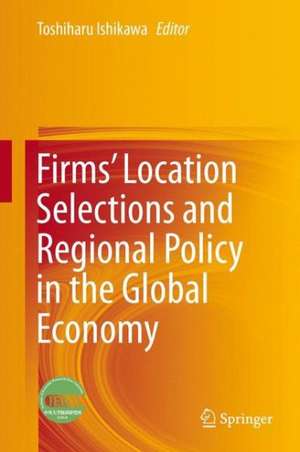Firms’ Location Selections and Regional Policy in the Global Economy
Editat de Toshiharu Ishikawaen Limba Engleză Hardback – 12 iun 2015
| Toate formatele și edițiile | Preț | Express |
|---|---|---|
| Paperback (1) | 640.71 lei 6-8 săpt. | |
| Springer – noi 2016 | 640.71 lei 6-8 săpt. | |
| Hardback (1) | 646.94 lei 6-8 săpt. | |
| Springer – 12 iun 2015 | 646.94 lei 6-8 săpt. |
Preț: 646.94 lei
Preț vechi: 761.10 lei
-15% Nou
Puncte Express: 970
Preț estimativ în valută:
123.81€ • 127.90$ • 103.04£
123.81€ • 127.90$ • 103.04£
Carte tipărită la comandă
Livrare economică 25 martie-08 aprilie
Preluare comenzi: 021 569.72.76
Specificații
ISBN-13: 9784431553656
ISBN-10: 4431553657
Pagini: 251
Ilustrații: XII, 288 p. 66 illus., 6 illus. in color.
Dimensiuni: 155 x 235 x 22 mm
Greutate: 0.6 kg
Ediția:2015
Editura: Springer
Colecția Springer
Locul publicării:Tokyo, Japan
ISBN-10: 4431553657
Pagini: 251
Ilustrații: XII, 288 p. 66 illus., 6 illus. in color.
Dimensiuni: 155 x 235 x 22 mm
Greutate: 0.6 kg
Ediția:2015
Editura: Springer
Colecția Springer
Locul publicării:Tokyo, Japan
Public țintă
ResearchCuprins
Part I Restructuring agglomeration to spatial production network (1 Firm location and agglomeration economies: Daisuke Nakamura.- 2 Fragmentation of production process due to growth and survival competition: Toshiharu Ishikawa.- 3 Supply chain, transportation, and spatial risk: Tatsuaki Kuroda.- 4 Formation of supply chains in East Asia: Yutaka Yamada)
Part II New location factors in global economy (5 Effects of the corporation tax rates on factory’s location through the function of the transfer price: Toshiharu Ishikawa.- 6 The Impact of transfer pricing regulations on the location decisions of MNEs: Junpei Itoh and Yoshimasa Komoriya.- 7 International comparison of corporate taxation systems: Masahiro Shinohara
8 Features of industrial and economic structure as factors for firms’ Location selections: an analysis of ASEAN countries: Mitsuhiro Hayashi)
Part III Regional economic policies in global economy (9 The role of cities in Nordic regional development policy: Lars Westin and Martin Ericksson.- 10 Regional development policies in the Philippines: from diffusion to integration: Arianne Dela Rosa Dumayas)
Part IV Economic vitalization strategies of cities (11 The spatial distribution of wealth—A search for hot spots : Johan Lundberg.- 12 Establishing urbanity in a region abundance with natural resources, the case of Umeå Sweden : Lars Westin.- 13 Economic vitalization strategy of Schweinfurt, Germany: Simon Suffa.- 14 Economic vitalization strategy of Chongqing, China: Yan Sun and Yoji Taniguchi.- 15 City development in emerging economies: the case of Davao city in the Philippines: Arianne Dela Rosa Dumaya.- 16 Significance of constructing city system in regional policy: Toshiharu Ishikawa and Rickard Wall).
Part II New location factors in global economy (5 Effects of the corporation tax rates on factory’s location through the function of the transfer price: Toshiharu Ishikawa.- 6 The Impact of transfer pricing regulations on the location decisions of MNEs: Junpei Itoh and Yoshimasa Komoriya.- 7 International comparison of corporate taxation systems: Masahiro Shinohara
8 Features of industrial and economic structure as factors for firms’ Location selections: an analysis of ASEAN countries: Mitsuhiro Hayashi)
Part III Regional economic policies in global economy (9 The role of cities in Nordic regional development policy: Lars Westin and Martin Ericksson.- 10 Regional development policies in the Philippines: from diffusion to integration: Arianne Dela Rosa Dumayas)
Part IV Economic vitalization strategies of cities (11 The spatial distribution of wealth—A search for hot spots : Johan Lundberg.- 12 Establishing urbanity in a region abundance with natural resources, the case of Umeå Sweden : Lars Westin.- 13 Economic vitalization strategy of Schweinfurt, Germany: Simon Suffa.- 14 Economic vitalization strategy of Chongqing, China: Yan Sun and Yoji Taniguchi.- 15 City development in emerging economies: the case of Davao city in the Philippines: Arianne Dela Rosa Dumaya.- 16 Significance of constructing city system in regional policy: Toshiharu Ishikawa and Rickard Wall).
Textul de pe ultima copertă
This book offers a new understanding of how firms determine their location and what kinds of regional economic policies are needed to attract factories to a country and a region in a highly globalized economic setting. The theoretical and empirical analyses examine the influence of the transfer pricing system, corporate tax rates, and a country’s industrial structure on a firm’s decision to locate and the impact of firms’ location on regional economic activities. The theoretical analysis elucidates the importance of the above-mentioned factors in the firm’s selection of possible location. The empirical analysis uses as an example the case of a supply chain in East Asia. The empirical analysis is illustrated with the regional/spatial development experiences at the country level and city level of selected countries and cities. The analysis offers a perspective for understanding the spatial patterns of a cross-border production system.
Caracteristici
Explores the dynamics of firms' production activities in a highly globalized economy Focuses on transfer pricing and corporate tax rates as primary drivers of firm location decisions Integrates theory, empirical research, and case examples from Asia and Europe, and considers practical implications for policymakers to attract corporate investments
















